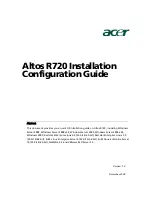
RAID Levels
2-21
2.5.6
RAID 6
RAID 6 is similar to RAID 5 (disk striping and parity), except that instead
of one parity block per stripe, there are two. With two independent parity
blocks, RAID 6 can survive the loss of two drives in a virtual drive without
losing data. Provides a high level of data protection through the use of a
second parity block in each stripe. Use RAID 6 for data that requires a
very high level of protection from loss.
In the case of a failure of one drive or two drives in a virtual drive, the
RAID controller uses the parity blocks to recreate all of the missing
information. If two drives in a RAID 6 virtual drive fail, two drive rebuilds
are required, one for each drive. These rebuilds do not occur at the same
time. The controller rebuilds one failed drive, and then the other failed
drive.
Table 2.6
provides a graphic example of a RAID 6 drive group.
Figure 2.8
shows a RAID 6 data layout. The second set of parity drives
are denoted by
Q
. The
P
drives follow the RAID 5 parity scheme.
Table 2.8
RAID 6 Overview
Uses
Use for office automation and online customer service
that requires fault tolerance. Use for any application that
has high read request rates but low write request rates.
Strong Points
Provides data redundancy, high read rates, and good
performance in most environments. Can survive the
loss of two drives or the loss of a drive while another
drive is being rebuilt. Provides the highest level of
protection against drive failures of all of the RAID levels.
Read performance is similar to that of RAID 5.
Weak Points
Not well-suited to tasks requiring a lot of writes. A RAID
6 virtual drive has to generate two sets of parity data for
each write operation, which results in a significant
decrease in performance during writes. Drive
performance is reduced during a drive rebuild.
Environments with few processes do not perform as
well because the RAID overhead is not offset by the
performance gains in handling simultaneous processes.
RAID 6 costs more because of the extra capacity
required by using two parity blocks per stripe.
Drives
3 to 32
Содержание ThinkServer RD230
Страница 1: ...ThinkServer RD230 RD240 and TD230 MegaRAID SAS Software User Guide ...
Страница 2: ......
Страница 3: ...ThinkServer RD230 RD240 and TD230 MegaRAID SAS Software User Guide ...
Страница 16: ...Contents ...
Страница 24: ...Contents ...
Страница 68: ...2 36 Introduction to RAID ...
Страница 252: ...7 10 MegaRAID Storage Manager Window and Menus ...
Страница 262: ...8 10 Configuration Figure 8 5 Virtual Drive Creation Menu The dialog box shown in Figure 8 6 appears ...
Страница 300: ...8 48 Configuration ...
Страница 328: ...9 28 Monitoring System Events and Storage Devices ...
Страница 334: ...10 6 Maintaining and Managing Storage Configurations ...
Страница 360: ...B 12 Glossary ...
Страница 363: ......
Страница 364: ......
















































